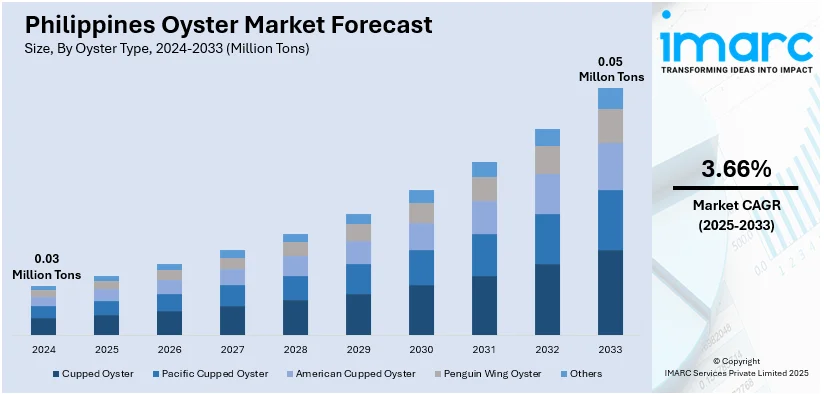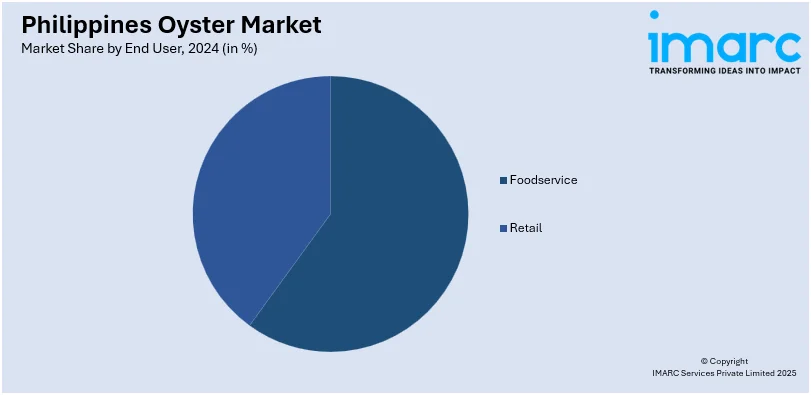
Philippines Oyster Market Size, Share, Trends and Forecast by Oyster Type, End User, Packaging Form, and Region, 2025-2033
Philippines Oyster Market Overview:
The Philippines oyster market size reached a volume of 0.03 Million Tons in 2024. Looking forward, the market is expected to reach a volume of 0.05 Million Tons by 2033, exhibiting a growth rate (CAGR) of 3.66% during 2025-2033. The market is fueled by rising consumer appetites for nutrient-dense seafood, heightened consciousness about the health advantages of oysters, and growing aquaculture activities along coastal areas. Increased numbers of local seafood restaurants and tourism also drive market expansion, providing possibilities for small-scale farmers and exporters. Financial support from the government for sustainable aquaculture and marine biodiversity conservation is further stimulating innovation in oyster cultivation methods and contributing to the Philippines oyster market share.
|
Report Attribute
|
Key Statistics
|
|---|---|
|
Base Year
|
2024
|
|
Forecast Years
|
2025-2033
|
|
Historical Years
|
2019-2024
|
| Market Size in 2024 | 0.03 Million Tons |
| Market Forecast in 2033 | 0.05 Million Tons |
| Market Growth Rate 2025-2033 | 3.66% |
Philippines Oyster Market Trends:
Expansion of Sustainable Aquaculture Practices
Increased focus on sustainable aquaculture is one of the most significant trends impacting the Philippines oyster market. As an increasing global and local issue is raised about the ecological effects of conventional seafood gathering, oyster farmers in various areas such as Capiz, Bataan, and Pangasinan have been using environmentally friendly practices in raising them. These are floating rafts and longline systems that disrupt sea beds as little as possible and better water quality monitoring procedures. Local government units (LGUs) and national institutions are encouraging sustainable aquaculture through training and provision of support to small-scale farmers to adopt best practices. The country's archipelagic nature provides extensive coastal waters ideal for oyster culture, and producers are capitalizing on this natural advantage while working toward maintaining marine diversity. As domestic and export markets increasingly demand responsibly sourced seafood, the transition to sustainability is placing Filipino oyster farmers on a path to fulfilling both environmental and business requirements, which also supports the Philippines oyster market growth.

To get more information on this market, Request Sample
Increasing Demand in Local and Export Markets
The market for Philippines oysters is seeing increasing demand from the local market and from international markets, especially Southeast Asia and the Middle East. Locally, oysters are a staple food in the Philippines, used in traditional recipes and eaten abundantly during festivals and celebrations. As the foodservice sector recovers and tourism returns, restaurants and hotels are stepping up their purchases of high-quality, fresh oysters, further increasing local demand. Meanwhile, exporters are riding on the fame of oysters from provinces such as Capiz, commonly referred to as the "Seafood Capital of the Philippines," to promote high-quality oysters overseas. Investments in cold chain facilities and enhanced post-harvest handling have improved the shelf life and quality of oysters, which are now more competitive in international markets. Such innovations mirror a larger pattern of modernization in the Philippine aquaculture industry that is set to harmonize Philippine oyster farming to international standards while meeting multifaceted consumer demands.
Farming Techniques and Value-Added Products Innovation
Innovation is assuming a growing role in determining Philippines oyster market trends. Producers and farmers are seeking new technologies and techniques to distinguish between better yield, quality, and profitability. Hatchery production has taken hold, diminishing reliance on wild seed gathering and providing for a more stable and sustainable oyster supply. Furthermore, research centers and local cooperatives are working on breeding methods to create disease-resistant oyster strains adaptable to different salinity and climate conditions. Another trend is the production of value-added oyster products like smoked oysters, oyster sauces, and ready-to-eat oyster packs, which respond to shifting consumer lifestyles and have a longer shelf life. These value-added products are gaining traction in supermarkets and export channels, providing diversified revenue streams for oyster farmers. These innovations are pushing the Philippine oyster business out of conventional farming and into more technologically and commercially developed ground, establishing its position in local and foreign seafood markets.
Philippines Oyster Market Segmentation:
IMARC Group provides an analysis of the key trends in each segment of the market, along with forecasts at the country and regional levels for 2025-2033. Our report has categorized the market based on oyster type, end user, and packaging form.
Oyster Type Insights:
- Cupped Oyster
- Pacific Cupped Oyster
- American Cupped Oyster
- Penguin Wing Oyster
- Others
The report has provided a detailed breakup and analysis of the market based on the oyster type. This includes cupped oyster, Pacific cupped oyster, American cupped oyster, Penguin wing oyster, and others.
End User Insights:

- Foodservice
- Retail
- Supermarkets and Hypermarkets
- Convenience Stores
- Specialty Outlets
- Online Channels
- Others
The report has provided a detailed breakup and analysis of the market based on the end user. This includes foodservice and retail (supermarkets and hypermarkets, convenience stores, specialty outlets, online channels, and others).
Packaging Form Insights:
- Fresh
- Frozen
- Canned
- Others
A detailed breakup and analysis of the market based on the packaging form have also been provided in the report. This includes fresh, frozen, canned, and others.
Regional Insights:
- Luzon
- Visayas
- Mindanao
The report has also provided a comprehensive analysis of all the major regional markets, which includes Luzon, Visayas, and Mindanao.
Competitive Landscape:
The market research report has also provided a comprehensive analysis of the competitive landscape. Competitive analysis such as market structure, key player positioning, top winning strategies, competitive dashboard, and company evaluation quadrant has been covered in the report. Also, detailed profiles of all major companies have been provided.
Philippines Oyster Market News:
- In September 2025, the Department of Science and Technology (DOST) announced its efforts to enhance the oyster and mussel sector in Capiz through innovations based on research and technologies for post-harvest activities. Capiz, recognized as the “Seafood Capital of the Philippines,” significantly contributes to the nation's production of oysters and mussels, with numerous locals depending on aquaculture for their income. DOST Capiz Provincial Science and Technology Director Juafe Abareles, in a segment of PIA Kapihan, emphasized the main projects aiding the industry, particularly the Single Oyster and Longline Mussel technologies.
- In March 2025, the city administration planned to cook approximately 200 sacks of oysters for attendees at the Talaba (Oyster) Festival on March 12, showcasing a key feature of the year's Hundred Islands Festival. Rosalie Aruelo, head of City Environment and Natural Resources, stated that the oysters were collected from farms located in Barangays Baleyadaan, Mona, Cayucay, and Pangapisan.
Philippines Oyster Market Report Coverage:
| Report Features | Details |
|---|---|
| Base Year of the Analysis | 2024 |
| Historical Period | 2019-2024 |
| Forecast Period | 2025-2033 |
| Units | Million Tons |
| Scope of the Report |
Exploration of Historical Trends and Market Outlook, Industry Catalysts and Challenges, Segment-Wise Historical and Future Market Assessment:
|
| Oyster Types Covered | Cupped Oyster, Pacific Cupped Oyster, American Cupped Oyster, Penguin Wing Oyster, Others |
| End Users Covered |
|
| Packaging Forms Covered | Fresh, Frozen, Canned, Others |
| Regions Covered | Luzon, Visayas, Mindanao |
| Customization Scope | 10% Free Customization |
| Post-Sale Analyst Support | 10-12 Weeks |
| Delivery Format | PDF and Excel through Email (We can also provide the editable version of the report in PPT/Word format on special request) |
Key Questions Answered in This Report:
- How has the Philippines oyster market performed so far and how will it perform in the coming years?
- What is the breakup of the Philippines oyster market on the basis of oyster type?
- What is the breakup of the Philippines oyster market on the basis of end user?
- What is the breakup of the Philippines oyster market on the basis of packaging form?
- What is the breakup of the Philippines oyster market on the basis of region?
- What are the various stages in the value chain of the Philippines oyster market?
- What are the key driving factors and challenges in the Philippines oyster market?
- What is the structure of the Philippines oyster market and who are the key players?
- What is the degree of competition in the Philippines oyster market?
Key Benefits for Stakeholders:
- IMARC’s industry report offers a comprehensive quantitative analysis of various market segments, historical and current market trends, market forecasts, and dynamics of the Philippines oyster market from 2019-2033.
- The research report provides the latest information on the market drivers, challenges, and opportunities in the Philippines oyster market.
- Porter's five forces analysis assist stakeholders in assessing the impact of new entrants, competitive rivalry, supplier power, buyer power, and the threat of substitution. It helps stakeholders to analyze the level of competition within the Philippines oyster industry and its attractiveness.
- Competitive landscape allows stakeholders to understand their competitive environment and provides an insight into the current positions of key players in the market.
Need more help?
- Speak to our experienced analysts for insights on the current market scenarios.
- Include additional segments and countries to customize the report as per your requirement.
- Gain an unparalleled competitive advantage in your domain by understanding how to utilize the report and positively impacting your operations and revenue.
- For further assistance, please connect with our analysts.
 Request Customization
Request Customization
 Speak to an Analyst
Speak to an Analyst
 Request Brochure
Request Brochure
 Inquire Before Buying
Inquire Before Buying




.webp)




.webp)












